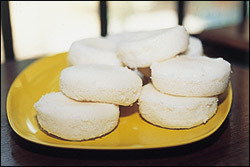


 The Bunt, Christian and Moplah Cuisines Of Mangalore
The Bunt, Christian and Moplah Cuisines Of Mangalore
FARZANA CONTRACTOR describes the Taj Group�s Hotel Manjarun in There are three major cuisines in Mangalore: the Bunt community of South Kanara, has the spicy, non-vegetarian food of the Brahmins and the coconut milk chicken and fish curries of the Shetty community; the flavoursome beef, pork and fish food of the Christians; and, the wholesome and hot, Arab-influenced cuisine of the Moplah community of Malabari Muslims from Kasargod. An UpperCrust team visited the homes of eminent families of each community. |
|
IT was Vimla Patil, cookery book writer, restaurateur and foodie, who once said that when fresh coconut, chillies and the Mangalorean mind fuse together, the result can only be culinary magic. How true! The coastal city of Mangalore has such a vast and traditional variety of foods, that when combined together, they showcase the ingenuity of another genre of Indian cuisine. Enterprising restaurateurs have successfully taken the cuisines out of the gourmet city to do thriving businesses elsewhere in the country. And while they have attracted local talent to come and do their cooking out of love
and adventure, if you want to really enjoy Mangalorean food, you must go to Mangalore city and get yourself invited to
people's homes.
The concept of �eating out� has not caught on in a big way in Mangalore city itself, because the simple but contented Mangalorean knows that the home fires burn finest. The gourmet instincts of the Mangalorean housewife have perfected over generations the art of improvising and making maximum use of natural produce available in the city. Mangalore falls under the rich and bountiful Konkan region of the south-west coast. This coast is lush with paddy fields and coconut-laden palms. The sea alongside, and also its rivers, creeks and small ponds, are teeming with pomfret, jumbo prawns, kingfish, ladyfish, lobster, mussels and clams. Only the freshest catch of the day will make the Mangalorean housewife's table. Like the vegetables, an excellent choice from among those locally grown.
The eminent Mangalorean master chef Ananda Solomon says that the central cooking of Mangalore city and its three main communities revolves around three ingredients: fish, rice and coconut. Grated, roasted or just by itself, coconut lends body to the local curries. Fresh or dried coconut (copra) punched with chillies is a must in most masala preparations. And there is rice, fine, fat, unpolished and even red, that is eaten boiled and also in the form of dosai, fine white neer dosai, parathas and spongy aapams. The Mangalorean housewive has a gifted hand at cooking. And she is a traditionalist. She cooks at home the old-fashioned way. Her spices are stone-ground. The cooking is done over wood or coal fires. Her cooking pots are made of mud or copper, they lend a special flavour to the food that is not found in any other type of cooking. Though almost every home has another kitchen, a modern, 21st century one, fully equipped with microwave, mixing and blending machines, and refrigerator.
|

Home Page
About the mag
Subscribe
Advertise
Contact Us